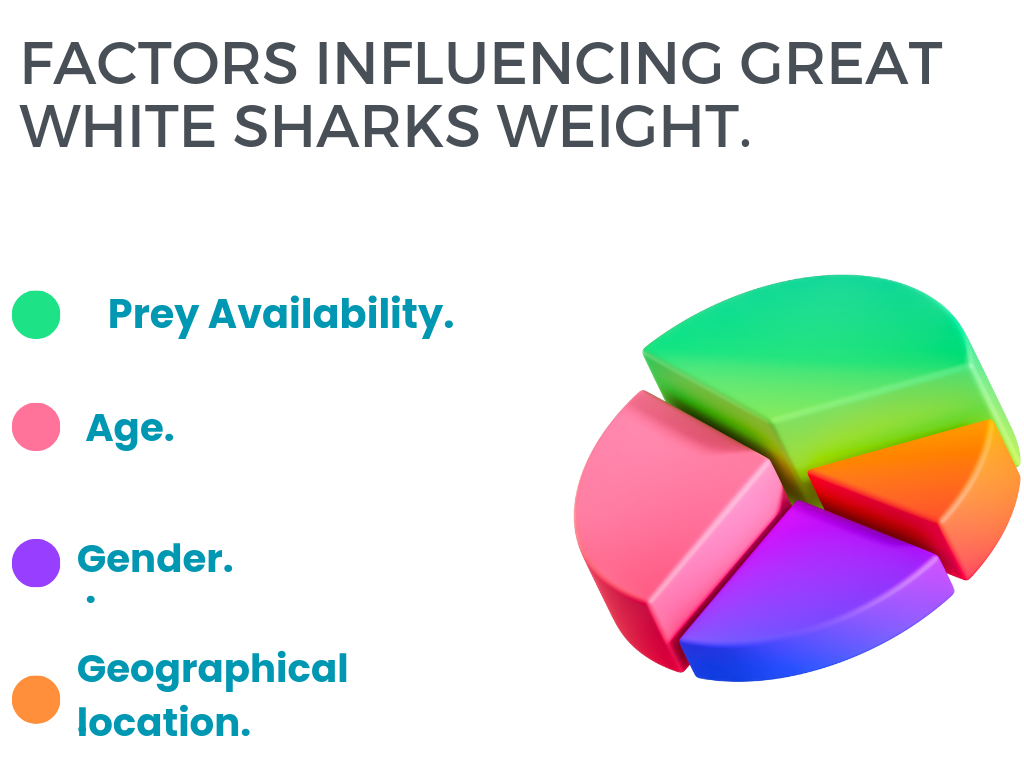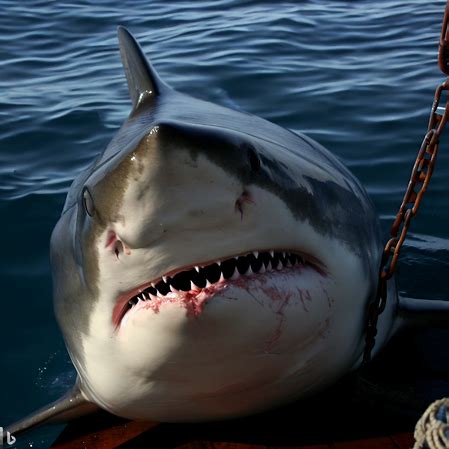
Key Takeaways
- The average weight of a great white shark is around 2,200 to 3,000 pounds.
- However, some great white sharks can weigh up to 5,000 pounds or more.
- The weight of a great white shark can vary depending on factors such as age, gender, and location.
- Female great white sharks tend to be larger and heavier than males.
- The weight of a great white shark is important for understanding its biology and behavior.
- Researchers use various methods, such as tagging and satellite tracking, to estimate the weight of great white sharks.
- Understanding the weight of great white sharks can help in conservation efforts and management strategies.
- The weight of a great white shark is an impressive feat of nature and highlights the incredible power and size of these apex predators.
To gain a deeper understanding of great white sharks and their weight, delve into the introduction of these magnificent creatures. Explore the importance of comprehending their weight, as it plays a crucial role in their behavior and ecology.
Introduction to Great White Sharks
Great White Sharks are amazing predators that have gained the attention of people everywhere. Their slim bodies and razor-sharp teeth inspire both wonder and fear.
These apex predators are rulers of the sea, commanding respect as one of nature’s greatest hunters.
To know more about these special creatures, we must look into their biology and behavior. Great Whites belong to the Lamnidae family and are called Carcharodon carcharias. They are greyish-white on top and white on the bottom. Their enormous jaws have many serrated teeth that help hunt prey.
They have a great sense of smell, picking up the faintest scent of blood from far away. This allows them to find seals, sea lions, and other animals in the water, which make up much of their diet. Great Whites can go fast too, reaching up to 35 miles per hour when attacking prey.
Unfortunately, these strong hunters are endangered by human activities such as pollution, overfishing, and getting stuck in fishing nets. Conservationists are working to save the majestic Great Whites and ensure they are around for future generations.
Exploring the world of Great White Sharks, we realize there is still much to learn. Marine biologists and researchers around the world are trying to uncover the mysteries of these deep-sea dwellers.
So take the plunge and get close to the grace and power of Great White Sharks. Join us as we discover the amazing things about this species before it’s too late. Don’t miss out on understanding such incredible predators – it would be a real loss.
Importance of understanding their weight
People often don’t give weight the credit it deserves. But weight has a huge effect on many areas of our lives. From physical health to self-esteem and mental well-being, weight matters.
Knowing how much we weigh helps us make smart decisions about what we eat and how much we exercise. We can set goals that are right for us. This gives us control over our health and helps us make healthy lifestyle choices.
Plus, being aware of our weight is important for monitoring and managing any health issues. Excess weight can lead to conditions like heart disease, diabetes, and joint problems. When we know our weight, we can take steps to stop these issues or get medical help if needed.
Lastly, understanding our weight helps us build a positive body image and promote mental wellbeing. Society places too much focus on looks. This can make us feel bad about our bodies and ourselves. But weight is just one part of who we are. By understanding this, we can have a healthier relationship with ourselves and appreciate our unique qualities.
Background Information
To understand the background information on the great white shark weight, dive into the physical characteristics of great white sharks and their habitat and distribution.
Physical characteristics of Great White Sharks
Great White Sharks boast special features that set them apart from other sea creatures. They have a streamlined body that enables them to move swiftly, reaching up to 35 miles per hour! Adults are typically 15-20 feet long, and their powerful tails further boost their speed.
Their upper bodies are dark gray or blue-black, aiding in hunting strategies. Rows of sharp teeth, numbering up to 300, help capture prey and deliver powerful bites.
Moreover, their senses enable them to detect prey from miles away. An acute sense of smell and eyes with the tapetum lucidum help them locate prey in low-light conditions. Lastly, they have a rete mirabile circulatory system, regulating their body temperature in cold waters.
Great White Sharks also have the remarkable ability to leap out of the water during hunting or territorial displays. This impressive behavior showcases their power and agility!
Fun Fact: National Geographic states that Great White Sharks can go up to three months without eating due to their slow metabolism.
Habitat and distribution
Amidst the sea of ecosystems, creatures have a place to survive. From rainforests to deserts, habitat and distribution determine where species can be located.
- In forests, diverse animals roam and blend with their surroundings.
- Tundras have animals that endure freezing temperatures and sparse vegetation.
- The ocean is full of life: fish, coral, and more.
- Grasslands have herds of majestic animals that connect to the earth.
- Mountains have flora and fauna that survive extreme heights and rough terrain.
Distribution patterns like climate and geography affect species’ locations. For example, the ocelot lives in the Amazon rainforest. It has a golden-spotted fur coat and moves through foliage with agility. This cat can be found in Central and South America.
Habitat and distribution shape the planet’s biodiversity. Let us appreciate these ecosystems with all their remarkable diversity.
Remember: Great white sharks can weigh up to 5,000 pounds. So if you want one as a pet, make sure your home has a reinforced aquarium!
Average Weight of Great White Sharks

To understand the average weight of great white sharks, delve into the factors influencing their weight and explore record-breaking weights. Factors such as age, gender, and diet contribute to variations in their weight, while record-breaking weights highlight the extraordinary size some individuals can attain.
Factors influencing their weight
The weight of Great White Sharks is influenced by a variety of factors. These include prey availability, age, gender, and geographical location.
Prey availability can heavily affect their weight. If food sources such as seals and sea lions are plentiful, the sharks will consume more, leading to increased size. Furthermore, mature sharks tend to be heavier than juvenile ones. Females also tend to be bigger than males. Lastly, those living in coastal areas have access to more prey, thus achieving higher average weights.
It’s important to understand these dynamics in order to protect these magnificent creatures and keep marine ecosystems balanced. On the other hand, the only thing scarier than a huge Great White Shark might be trying to fit into your skinny jeans after a summer of indulgence!
Record-breaking weights of Great White Sharks
The records of Great White Sharks’ weights are amazing! Deep Blue, the largest one ever recorded, weighed a massive 5,000 pounds. Predator and Joan followed close behind at 4,300 and 4,200 pounds respectively. These figures show the immense size that these ocean giants can reach. So if you ever find yourself near one while swimming or diving, remember to stay a safe distance away and not agitate or provoke them. Follow local regulations regarding interactions with Great White Sharks to protect both yourself and them. Let’s appreciate these powerful creatures and their impressive weight records while also preserving their natural habitat for future generations.
Importance of Weight for Great White Sharks

To understand the importance of weight for great white sharks, let’s delve into the hunting and feeding behavior as well as the breeding and reproductive strategies of these majestic creatures. By examining these sub-sections, we can gain valuable insights into how weight plays a crucial role in the lives of great white sharks.
Hunting and feeding behavior
The hunting & feeding behavior of Great White Sharks are vital for their survival. To understand better, let’s take a look at the following table:
| Hunting Behavior | Feeding Behavior |
|---|---|
| Ambush Predation | Scavenging |
| Situational | Forceful Biting |
| Cooperative | Gulping |
These creatures display adaptability when it comes to securing food. Their forceful biting & cooperative hunting increases their chances of success. They also have the ability to gulp down their catch.
Furthermore, they possess superb sensory capabilities. They can spot potential prey from far away with their eyes, ears & smell. The ampullae of Lorenzini also help them detect electromagnetic fields produced by living organisms underwater.
Scar is a female Great White Shark who lives near Seal Island, South Africa. She has developed a technique called “breaching,” where she propels herself out of the water with speed to capture Cape fur seals. This shows her ability to adjust her hunting strategy.
For breeding & reproduction strategies, Great White Sharks show that it’s not always easy to find a mate.
Breeding and reproductive strategies
To understand the complexities of these strategies, let’s focus on key data:
| Mating Behaviors | Females of the Great White Sharks mate with many males. |
| Gestation Periods | The gestation period is 12-18 months. |
| Number of Offspring Produced | 2-14 pups per litter. |
These facts provide insights into the unique breeding strategies of the Great White Sharks. Polyandrous mating ensures genetic diversity within their population.
The lengthy gestation period allows the pups to grow and develop before entering the outside world.
Furthermore, female Great White Sharks have oophagy, where certain embryos consume other eggs or weaker siblings in the mother’s womb.
And… did you know? The Great White Shark can reach up to 20 feet in length and weigh 2.5 tons! (Source: National Geographic).
Threats to Great White Sharks and Weight Loss
To understand the threats to Great White Sharks and weight loss, dive into the two key areas: human impacts on their weight and conservation efforts to protect the species. Explore how human activities affect their weight, and discover the initiatives aimed at safeguarding these magnificent creatures.
Human impacts on their weight
Human activities have a huge effect on great white sharks’ weight. Let’s look at some key factors that impact it.
Fishing Activities: Uncontrolled fishing often causes great white sharks to be caught unintentionally, making their population drop and their average weight shrink.
Pollution: Toxic substances released into the seas can contaminate the food chain, reducing prey for the sharks and negatively affecting their weight.
Habitat Destruction: If key habitats like coral reefs and coastal areas get destroyed, great white sharks won’t have enough hunting grounds and their body mass will decrease.
Also, due to overfishing, sharks may need to change their diet or migrate to find new food sources, which can affect their energy intake and weight.
Let me share with you a story of human interference impacting great white sharks’ weight. In the waters of a fishing village, the shark sizes had been getting smaller. Investigations showed that too much fishing and habitat destruction were the cause. Smaller sharks couldn’t fulfill their ecological role, hurting the local ecosystem.
In conclusion, human activities have a damaging effect on great white sharks’ weight. Knowing this is crucial for preserving these creatures and keeping our oceans balanced.
Conservation efforts to protect the species
Strict fishing regulations are key to preventing overfishing and accidental catches of Great White Sharks. Creating marine protected areas specifically for them, and raising public awareness about their importance in the ecosystem help foster support for their conservation. Research and monitoring of their behavior, breeding patterns, and migration routes are critical to understanding their needs. Working with local communities, governments, scientists, and conservation organizations is essential to successful conservation efforts.
Climate change, pollution, habitat loss, and illegal hunting are also factors contributing to the decline of Great White Shark populations and must be addressed at local and global levels.
A remarkable story highlighting the importance of conservation is that of Helen, a young female Great White Shark who was tagged as part of a research project. Tracking her journey across the oceans revealed her incredible ability to navigate habitats efficiently. This gave invaluable knowledge of their survival challenges and emphasized the need for continued conservation efforts.
Protecting Great White Sharks is essential for their survival, as well as for the health and balance of our oceans. Strict regulations, protected areas, public awareness, research, and collaborative partnerships are necessary for their future.
Studying and Measuring Great White Shark Weight
To thoroughly understand the weight of Great White Sharks, dive into the section on studying and measuring their weight. Explore the methods used to estimate weight and the challenges faced in accurately weighing these magnificent creatures. Let’s explore the solution with these two sub-sections.
Methods used to estimate weight
Estimating the weight of a Great White Shark involves multiple techniques, each with its own pros and cons.
These methods use scientific principles and calculations to determine the weight with precision. See the table below for an overview of the methods:
| Method | Description |
|---|---|
| Length-based | Estimation based on length using a particular formula. |
| Girth-based | Girth measurements combined with math models. |
| Photogrammetry | Analysis of photographs in relation to known lengths and weights. |
In addition to length and girth measurements, gender, age, and body shape are also taken into account.
Amazingly, scientists have discovered a strong connection between tooth size and body mass in Great White Sharks. By measuring a shark’s tooth width, its approximate weight can be estimated with accuracy. This shows how nature provides us with clues to unravel the mysteries of these magnificent creatures.
Challenges faced in weighing Great White Sharks
Weighing Great White Sharks can be tough. They’re huge and shy! To make it easier, scientists have created methods and tech to measure them.
Let’s look at the challenges and solutions:
Challenges:
- Difficult to access live specimens
- Estimating size and weight
- Unpredictable behavior
Solutions:
- Remote underwater cameras and drones
- Formulas based on length, girth, and known weight
- Tagging and tracking devices
Another way to measure Great White Shark weight is by photo-ID. This way, researchers can track size changes and be more accurate.
The heaviest recorded Great White Shark was 2,268 kilograms (5,000 pounds). It was caught off Prince Edward Island, Canada in 1988.
Let’s explore more! Let’s learn about the weighty world of great white sharks!
Implications and Future Research
To better understand the implications and future research related to great white shark weight, delve into the sub-sections: understanding the impacts of weight on shark populations, and the importance of continued research and monitoring.
Understanding the impacts of weight on shark populations
Weight impacts shark populations in a variety of ways, so understanding how it affects them is essential for effective management and conservation. Body size and reproductive success are linked, and by studying weight changes in a population, scientists can gain insight into survival and growth rates.
Weight impacts migratory patterns too. Heavier sharks may have an energetically efficient swimming style, allowing them to cover greater distances. This knowledge can help us protect critical habitats.
A study by Dr. Chris Fischer of OCEARCH revealed that tiger sharks lose weight during long-distance migrations, highlighting their amazing adaptability. Research is key to understanding these apex predators and protecting them.
Importance of continued research and monitoring
Research and monitoring are essential for gaining knowledge and understanding. We can check out new avenues and evaluate processes, spotting gaps and areas for improvement. Through this constant learning process, we can adapt strategies, policies, and practices to changing circumstances.
Continued research and monitoring enable us to detect patterns and dynamics in various domains. It helps us make decisions based on the most current info. Each study or analysis provides valuable insights that contribute to our collective body of knowledge.
In addition, research and monitoring foster innovation. By looking for new info and perspectives, we open ourselves up to discoveries and alternative approaches. This exploration encourages creativity and pushes boundaries, leading to breakthroughs.
We must set objectives and methodologies for research and monitoring to be successful. Regularly reviewing objectives and collaborating with stakeholders ensures quality outcomes. Longitudinal studies provide comprehensive insights, although they require sustained funding.
To promote research and monitoring, we must cultivate a culture of curiosity. Acknowledging achievements and sharing knowledge through conferences and publications stimulates collaboration among experts. Ultimately, the future of research is uncertain, yet intriguing.
Frequently Asked Questions
Q: How much does a great white shark weigh?
A: The average weight of a great white shark is between 1,500 to 2,400 kilograms (3,300 to 5,300 pounds).
Q: What is the maximum weight recorded for a great white shark?
A: The heaviest great white shark ever recorded weighed an estimated 3,324 kilograms (7,328 pounds).
Q: How does the weight of a great white shark compare to other sharks?
A: Great white sharks are one of the largest shark species, but they are not the heaviest. The whale shark holds the record for being the largest shark in terms of weight.
Q: How does the weight of a great white shark compare to other marine animals?
A: While great white sharks are impressive in size, they are not the largest marine animals. Species like the blue whale and the fin whale outweigh great white sharks by a significant margin.
Q: Can the weight of a great white shark vary based on its gender?
A: Yes, female great white sharks tend to be larger and heavier than males. Females can weigh up to 50% more than males.
Q: What factors can influence the weight of a great white shark?
A: The weight of a great white shark can vary based on factors such as age, health, diet, and geographic location. Younger sharks generally weigh less than older ones, and diet plays a crucial role in their growth and weight.
Conclusion
We’ve examined the weight of great white sharks. It varies depending on age, gender, and diet. These massive sea creatures are remarkable.
Their feeding habits and growth patterns influence their weight. Great whites consume large amounts of food, allowing them to maintain their size. As they mature, their diet mainly consists of marine mammals, making them heavier.
Females are larger and heavier than males due to the demands of reproduction. These calculations are only estimates based on research and observations by experts.
It’s hard to measure every individual shark accurately. But here’s an incredible fact! The heaviest female great white shark weighed 3,324 pounds (1,509 kg). That’s heavier than a small car! It’s amazing how powerful and majestic these apex predators are.
References
https://www.nationalgeographic.com/animals/fish/facts/great-white-shark




